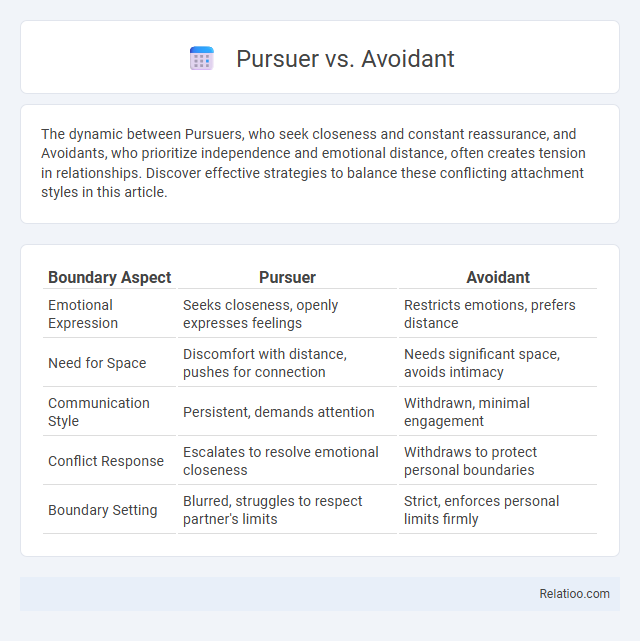The dynamic between Pursuers, who seek closeness and constant reassurance, and Avoidants, who prioritize independence and emotional distance, often creates tension in relationships. Discover effective strategies to balance these conflicting attachment styles in this article.
Table of Comparison
| Boundary Aspect | Pursuer | Avoidant |
|---|---|---|
| Emotional Expression | Seeks closeness, openly expresses feelings | Restricts emotions, prefers distance |
| Need for Space | Discomfort with distance, pushes for connection | Needs significant space, avoids intimacy |
| Communication Style | Persistent, demands attention | Withdrawn, minimal engagement |
| Conflict Response | Escalates to resolve emotional closeness | Withdraws to protect personal boundaries |
| Boundary Setting | Blurred, struggles to respect partner's limits | Strict, enforces personal limits firmly |
Understanding Pursuer and Avoidant Dynamics
Understanding the dynamics between pursuer and avoidant attachment styles reveals the core challenges in many relationships, where the pursuer seeks closeness and reassurance while the avoidant values independence and emotional distance. You can navigate these differences by recognizing the avoidant's need for space and the pursuer's desire for connection, fostering empathy and improving communication. Effective strategies involve setting boundaries that respect both partners' needs and developing emotional regulation skills to reduce conflict.
Key Traits of the Pursuer Attachment Style
The Pursuer attachment style is characterized by a strong desire for closeness, emotional connection, and constant reassurance within relationships. Individuals with this style often exhibit anxiety about abandonment, a tendency to seek approval, and difficulty tolerating distance or silence from their partners. Their key traits include high empathy, intense communication needs, and a persistent drive to resolve conflicts quickly to maintain relational harmony.
Core Characteristics of the Avoidant Attachment Style
The core characteristics of the avoidant attachment style include a strong desire for independence, discomfort with emotional closeness, and difficulty trusting others, often leading to emotional distance in relationships. Individuals with avoidant attachment tend to suppress their feelings and prioritize self-reliance, which can create challenges when paired with a pursuer who seeks more connection. Understanding these traits can help you navigate relationship dynamics more effectively and foster healthier communication.
How Pursuer and Avoidant Patterns Develop
Pursuer and avoidant attachment patterns develop primarily through early caregiver interactions, where inconsistent emotional availability or over-involvement shapes these behavioral responses. Pursuers often emerge from environments where their emotional needs were unpredictably met, leading to a heightened desire for closeness and reassurance. Avoidants tend to develop when caregivers were dismissive or unresponsive, causing individuals like you to prioritize independence and emotional distance to protect themselves from rejection or neglect.
Emotional Impact of Pursuer vs Avoidant Interactions
Interactions between pursuers and avoidants often generate intense emotional turbulence, as pursuers seek closeness and reassurance while avoidants strive for distance and independence. This dynamic can trigger heightened anxiety for pursuers who feel rejected or ignored, and increased frustration or overwhelm for avoidants who perceive pressure or intrusion. Chronic mismatches in emotional needs may erode trust and intimacy, leading to recurring cycles of pursuit and withdrawal that intensify emotional distress for both partners.
Common Challenges in Pursuer-Avoidant Relationships
Pursuer-avoidant relationships often face common challenges such as emotional distance and intensified conflicts due to differing attachment styles. The pursuer seeks closeness and reassurance, while the avoidant prioritizes independence and may withdraw, creating a cycle of frustration. Understanding these dynamics helps you navigate communication barriers and build healthier intimacy.
Communication Breakdown Between Pursuer and Avoidant
Communication breakdown between Pursuer and Avoidant attachment styles often stems from conflicting needs where the Pursuer seeks closeness and reassurance, while the Avoidant craves space and independence. Your attempts to engage may trigger the Avoidant to withdraw further, intensifying frustration and emotional distance. Understanding these patterns is essential to developing healthier communication strategies that respect boundaries while addressing emotional needs.
Healing and Growth for Pursuers and Avoidants
Pursuers often experience intense longing for connection and may struggle with anxiety, while avoidants tend to prioritize independence and distance, leading to emotional withdrawal. Healing for Pursuers involves developing self-soothing techniques and embracing healthy boundaries, whereas Avoidants benefit from cultivating open communication and vulnerability. Your growth hinges on understanding these patterns, fostering empathy, and practicing consistent emotional regulation to build secure, balanced relationships.
Strategies to Balance Attachment Differences
Balancing attachment differences between a pursuer and an avoidant requires clear communication and establishing personal boundaries to foster mutual understanding. Implementing consistent emotional availability and encouraging vulnerability helps reduce anxiety and build trust within the relationship. Utilizing individual and couples therapy techniques can support adaptive coping strategies, promoting secure attachment behaviors for both partners.
Building Secure Attachment: Moving Beyond Pursuer vs Avoidant
Building secure attachment involves recognizing and moving beyond the pursuer vs avoidant dynamic by fostering open communication and emotional safety. You can develop empathy and self-awareness that addresses both pursuing behaviors and avoidance patterns to create trust and intimacy. Prioritizing mutual vulnerability helps transform insecure attachment styles into a secure, balanced connection.

Infographic: Pursuer vs Avoidant
 relatioo.com
relatioo.com